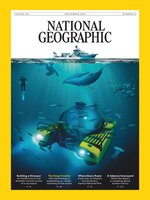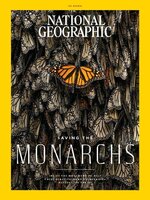Amazing discoveries and experiences await you in every issue of National Geographic magazine. The latest news in science, exploration, and culture will open your eyes to the world’s many wonders.
FROM the EDITOR
IN FOCUS • JUST IN FROM OUR PHOTOGRAPHERS
CAPTURING NEW VIEWS OF HYENAS • Aided by specialized cameras, this photographer is revealing the secret lives of Africa’s most misunderstood animals.
NATIONAL GEOGRAPHIC EXPLORERS • These contributors have received funding from the National Geographic Society, which is committed to illuminating and protecting the wonder of our world.
The Last Laugh • In the spotted hyenas’ world, females rule. That may be the secret to their success.
Ultimate Hunters • Spotted hyenas live in socially complex, female-dominated clans that can range from six to 130 animals. Although they look like dogs, they’re more closely related to cats. Contrary to popular belief, they’re not just scavengers but also highly efficient hunters that kill up to 95 percent of their food. From their powerful jaws to their advanced communication strategies, these hyenas reign when on the hunt.
Realm of the Hyena • Adapted to nearly every habitat—from deserts to savannas, open woodlands to urban areas—four species of hyenas have made Africa their home. The most abundant large carnivore on the continent: the spotted hyena.
QUEENS • FEMALE POWER IN THE NATURAL WORLD
Her SECRET GUARDIANS • When Anne Boleyn was executed in 1536, her prized book of hours went missing for centuries. Now we know who helped keep it safe.
UNVEILING THE MAYA • THE WORLD THE MAYA MADE HAS BEEN SHROUDED BY JUNGLE FOR CENTURIES. NOW A REVOLUTIONARY TECHNOLOGY IS REVEALING ITS STAGGERING SCALE AND SOPHISTICATION.
THE MIGHTY MAYA • Dozens of Maya city-states strove dominance over two millennia—trading, mingling, and warring until the last of them were conquered by Spain in the 16th century. Today, remote sensing laser technology called lidar is peering through entangled jungle to reveal a fuller picture of how more than 6,000 sites once supported millions of people.
HIDDEN CITY SPRAWL • DENSE FORESTS HAVE CLOAKED THE EXTENT OF MAYA CIVILIZATION FOR NEARLY A THOUSAND YEARS. NOW IT’S COMING TO LIGHT.
SUBURBAN STRENGTH • Beyond Tikal’s urban core were clusters of residential compounds with plazas surrounded by homes, kitchens, and gardens. In these social, administrative, and commercial hubs, people sold goods in the market and paid tribute—sometimes in the form of exotic items and even captives—to local elites. This scene, based on the work of archaeologists from the region and other experts, illustrates how this network of neighbor-hoods throughout the hinterland supported the flow of a city’s resources.
TOXIC BEAUTY
BEST OF THE WORLD 2024 • FROM A HORSEBACK SAFARI IN KENYA TO RIVER RAFTING IN WEST VIRGINIA, HERE’S OUR LIST OF THE TOP 20 TRAVEL EXPERIENCES RIGHT NOW, CURATED BY NATIONAL GEOGRAPHIC EXPLORERS, PHOTOGRAPHERS, AND EDITORS.
CLUES in the STONE AGE BEADS
FOOD FIGHT • Interactions between birds at a feeder may look chaotic, but there’s a method to the madness. A hierarchy of species’ social dominance—shown here with the downy woodpecker as a point of comparison—governs everything from food access to perch position.
LIVING WITH DEMENTIA • Cases of dementia are rising around the world. The disease has no cure, but caregivers and families are finding innovative ways for patients to live with dignity.
REDUCING THE RISK OF DEMENTIA • Dementia, a complex group of symptoms caused by brain damage and resulting from multiple diseases, can impair cognitive function and affect a person’s daily life. Some of its impact, however, could be prevented or delayed by addressing these 12 behaviors and...

 Jan 01 2025
Jan 01 2025
 Dec 01 2024
Dec 01 2024
 Nov 01 2024
Nov 01 2024
 Oct 01 2024
Oct 01 2024
 Sep 01 2024
Sep 01 2024
 Aug 01 2024
Aug 01 2024
 Jul 01 2024
Jul 01 2024
 Jun 01 2024
Jun 01 2024
 May 01 2024
May 01 2024
 Apr 01 2024
Apr 01 2024
 Mar 01 2024
Mar 01 2024
 Feb 01 2024
Feb 01 2024
 Jan 01 2024
Jan 01 2024
 Dec 01 2023
Dec 01 2023
 Nov 01 2023
Nov 01 2023
 Oct 01 2023
Oct 01 2023
 Sep 01 2023
Sep 01 2023
 Aug 01 2023
Aug 01 2023
 Jul 01 2023
Jul 01 2023
 Jun 01 2023
Jun 01 2023
 May 01 2023
May 01 2023
 Apr 01 2023
Apr 01 2023
 Mar 01 2023
Mar 01 2023
 Feb 01 2023
Feb 01 2023
